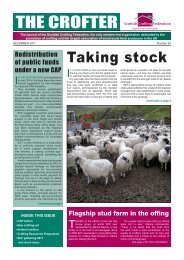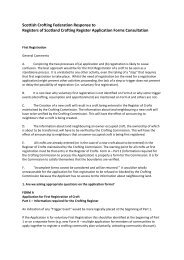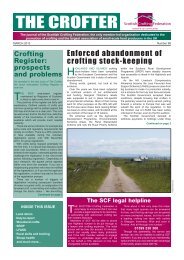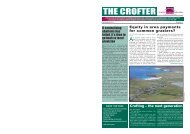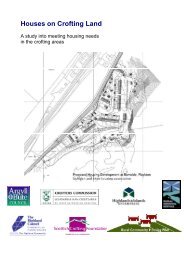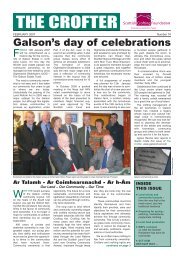Crofter 82 - Scottish Crofting Federation
Crofter 82 - Scottish Crofting Federation
Crofter 82 - Scottish Crofting Federation
Create successful ePaper yourself
Turn your PDF publications into a flip-book with our unique Google optimized e-Paper software.
16<br />
W<br />
e give the bees their Christmas<br />
present ideally on the first calm and<br />
sunny day of the year; a slab of<br />
confectioner’s fondant placed on top of the<br />
brood box.<br />
Unfortunately, on Skye where we live, it is<br />
seldom sunny or calm in January. This year<br />
we battled in one of the many early January<br />
gales to remove the various shelters we have<br />
built around our beehives to protect them from<br />
the winter winds – and more importantly rain<br />
(bees hate the wet) – and hastily inserted the<br />
sugar before the bees succumbed to the wet<br />
and cold.<br />
It is not easy keeping bees this far north<br />
and in such a wet climate. It is marginal at the<br />
best of times – but it is possible. We took over<br />
20lbs of honey off one of our hives this year<br />
and many folk locally took a lot more. But the<br />
amount is risible when it is compared to the<br />
90lbs or more it is possible to take off a hive<br />
further south and still leave sufficient stores for<br />
the bees for winter. Here, however it is essential<br />
to feed bees through the winter whether one<br />
takes honey off or not, for colonies regularly<br />
die out – not due to the causes currently being<br />
reported in the national press: varroa mite,<br />
colony collapse syndrome, pesticides – but<br />
simply due to starvation.<br />
Skye thankfully remains one of the few<br />
varroa-free areas left in Britain, for in such a<br />
marginal area for bee keeping varroa could<br />
well spell its end. When we moved to Skye<br />
there was still a ban on importing bees to the<br />
island. Unfortunately this restriction has since<br />
LOCAL FOOD PRODUCTION<br />
been lifted as officially the whole of the British<br />
Isles is now considered contaminated with<br />
varroa. Tests run by the Skye and Lochalsh<br />
Beekeepers last year, however, suggest that<br />
Skye is still varroa free and we are all extremely<br />
keen to keep it that way. This means it is vital<br />
for bee keepers locally to breed new colonies<br />
to restock hives and to supply the growing<br />
number of new beekeepers and thereby<br />
reduce the likelihood that infected stocks are<br />
imported.<br />
Despite all the publicised difficulties, bee<br />
keeping – certainly locally – does seem to be<br />
becoming increasingly popular. Personally<br />
I am not surprised, as bees are absolutely<br />
fascinating creatures for which there should<br />
be a place on any croft. They can be as little<br />
or as much work as you wish. Some folk keep<br />
bees simply as pollinators, never managing<br />
them for honey and simply leaving them to<br />
breed and naturally re-queen. Others, like<br />
ourselves, are more proactive and during the<br />
season (May to September) go through the<br />
hives every 10 days or so to check things are<br />
progressing as we would like.<br />
Even though a lot of crofts these days are<br />
essentially used for grazing they would still be<br />
able to provide the forage (flowers) that bees<br />
need to gather both the pollen and nectar<br />
required to survive. Hazel and the hated whin<br />
are invaluable sources of early pollen for the<br />
young brood in the spring. Spring flowers such<br />
as bluebells and primrose are good sources<br />
of nectar, as are meadowsweet and brambles<br />
later in the year. Then there is the heather at<br />
THE CROFTER, MARCH 2009<br />
The buzzing of the bees<br />
T<br />
he wool used was home grown on<br />
Kathy’s croft in Fair Isle. The yarns are<br />
hand-spun in Fair Isle, and mill-spun at<br />
the Mini-Mill in North Ronaldsay. The weaving<br />
was done by Kathy, with the assistance of the<br />
<strong>Crofting</strong> Mark<br />
Centre for Creative Industries in Sellafirth. The<br />
knitting was, of course, done on Fair Isle.<br />
The produce, therefore, covers a large part<br />
of the Northern Isles!<br />
www.KathyCoull.com<br />
the end of the season which can be absolutely<br />
fantastic forage and produces the wonderful<br />
rich-tasting honey for which Scotland is<br />
famous.<br />
So, even though the amount of honey at<br />
the end of the season and the difficulties of<br />
keeping bees on the west coast would perhaps<br />
not make a viable business by itself, there<br />
is still an incredible value to keeping bees,<br />
whether as pollinators, to help supplement<br />
other incomes, or for the simple pleasure of<br />
hearing the buzzing of the bees.<br />
Jenny Hey<br />
For further information on keeping bees in<br />
Skye and Lochalsh please contact Mark<br />
Purrett, secretary to Skye and Lochalsh Bee<br />
Keepers Association: 01471 866207<br />
The <strong>Crofting</strong> Mark in use, promoting products by Kathy Coull<br />
Às a’ chroit anns a’ Ghàidhealtachd ‘s na h-Eileanan




